#Rundell Bridge and Rundell
Explore tagged Tumblr posts
Text
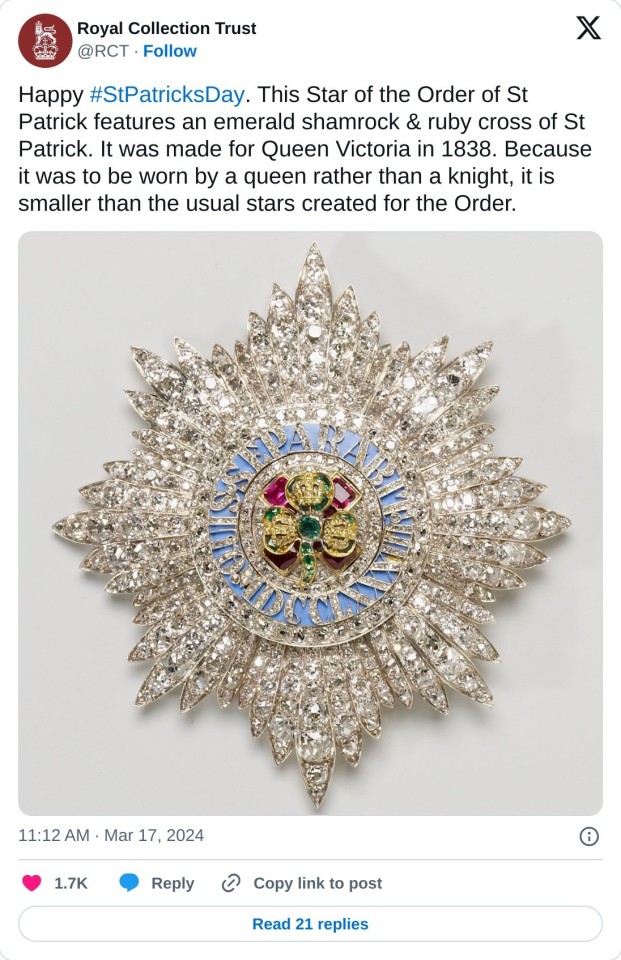

DESCRIPTION:
Silver St Patrick star, set with diamonds; eight-pointed star; centre: ruby St Patrick's cross overlaid with emerald shamrock applied with three gold crowns surrounded by motto QUIS SEPARABIT MDCCLXXXIII, in diamonds on light blue enamel; surrounded by circle of diamonds. Back plate gold; pin gilt.
Queen Victoria was supplied by Rundell Bridge and Rundell with the star of the Order of St Patrick presumably at the same time as the Garter and Bath stars, which had been supplied in September 1838.
However, no invoice to confirm exact delivery survives.
These stars, all of reduced size to a standard star of the time, formed the pattern for the Queen’s subsequent purchases of insignia, including the Star of the Order of the Star of India designed by the Prince Consort.
#St. Patrick's Day#Star of the Order of St. Patrick#St. Patrick#Queen Victoria#British Royal Family#Rundell Bridge and Rundell
19 notes
·
View notes
Text
Queen Adelaide’s Fringe Necklace

In 1831, King William IV, uncle of Queen Victoria, commissioned Rundell and Bridge to make a necklace for his wife, Queen Adelaide.
At 46cm in length, the necklace was made up of of 133 sections, consisting a total of 1,456 stones, which had been taken out of redundant pieces of jewellery owned by King George III and Queen Charlotte.
Upon the death of her husband, Adelaide gave the necklace to the new monarch, Queen Victoria.
On 15th November 1837, Victoria wore the necklace, which she had created into a tiara, to one of her first visits to the theatre as Queen.

In the 1858 inventory of jewels, the necklace was recorded to be considered a heirloom of the Crown.

Elizabeth, the Queen Mother had the fringe remade into a necklace, adding a "concealed snap". Although her husband died in 1952, Elizabeth was allowed to keep the necklaces along with other pieces of jewellery. However, after her death in 2002, they were returned to the crown.
Unfortunately Queen Elizabeth Il never wore the necklace publicly.
#british royal family#thejewelcatalogue#jewel;necklace#Queen Adelaide’s Fringe Necklace#queen victoria#the queen mother
69 notes
·
View notes
Photo

William Theed the Elder, 1764-1817
Thetis returns from Vulcan with the armour of Achilles, bronze, cast, chased and patinated, on an integral rectangular plint, 128x120x143 cm
Private Collection
This spectacular sculpture is described by Sir Timothy Clifford as ‘undoubtedly Theed’s most ambitious work’. Theed exhibited a small wax model of it at the Royal Academy in 1805 and its subject would have had huge contemporary resonance as it was probably modelled in the dark days of late 1804/5 when Britain’s navy was pitched not only against the fleets of Napoleonic France but also those of Spain. The British Isles was in imminent danger of invasion, so Achilles’ heavenly armour arriving at the hour of need would have had a strong symbolic message. Theed exhibited a similar-sized bronze in 1812, probably identical to the group in the collection of H.M. The Queen at Windsor, and others continued to be cast by Rundell, Bridge and Rundell as late as 1829.
13 notes
·
View notes
Text

Royal Collection Trust | Philip Rundell, Shield of Achilles, 1821, Silver gilt, 90 1/2 × 90 1/2 × 10 in | 229.9 × 229.9 × 25.4 cm. Supplied to George IV by Rundell, Bridge and Rundell, 1821.
8 notes
·
View notes
Text

Queen Adelaide's Diamond Brooch, Rundell & Bridge, 1831


Queen Alexandra (1901)
Queen Mary (1934)
Queen Elizabeth The Queen Mother (1946) /
Queen Elizabeth II (1966)
Queen Elizabeth II (2013)
90 notes
·
View notes
Text

King Charles III will reuse vestments which featured in the Coronation Services of King George IV in 1821, King George V in 1911, King George VI in 1937 and Queen Elizabeth II in 1953, including the Colobium Sindonis, the Supertunica, the Imperial Mantle, the Coronation Sword Belt and the Coronation Glove.
The Monarch is invested with the Colobium Sindonis after the Anointing. It takes the form of a white linen shift-like tunic, and a plain collar fastened with a single button, intended to represent a priests' alb. The King will use the Colobium Sindonis worn at the Coronation of his grandfather King George VI at Westminster Abbey on 12th May 1937, which was made by the robemakers Ede & Ravenscroft.
The Supertunica takes the form of a full-length, sleeved gold coat and is worn under the Imperial Mantle. The Sovereign is invested with the Supertunica following the Anointing and it is fastened with the Coronation Sword Belt.
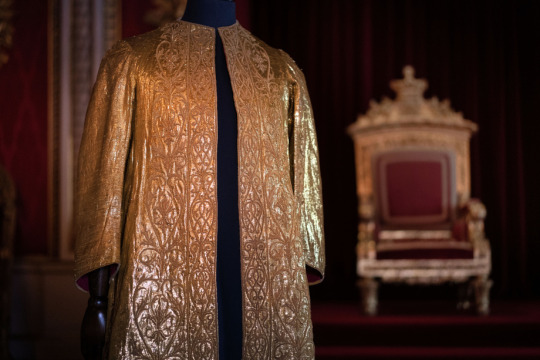
Although this Supertunica dates from the twentieth century, the form of the Supertunica has changed little since medieval coronations. The design of the Supertunica is based on priestly and religious vestments.
Each side of the front of the Supertunica features an embroidered band with spiral threads, which take the shape of leafy stems using the goldwork technique. The embroidery was carried out in 1911 by the Ladies Work Society and, as part of the centuries-old tradition for the Supertunica, is based on ecclesiastical vestments from medieval times.
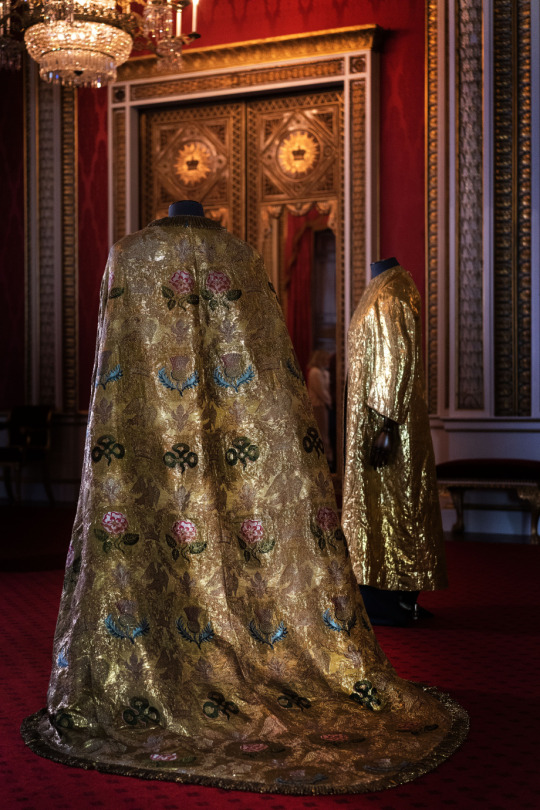
The Imperial Mantle is worn over the Supertunica and is more similar in design to a robe. The Imperial Mantle being used by the King at this year’s Coronation was made for the Coronation of George IV in 1821, and has been worn by King George V, King George VI and Queen Elizabeth II. It is the oldest vestment being used in the Coronation Service.
The Imperial Mantle is made of cloth of gold, gold, silver and silk thread, silk, gold bullion fringe and a gold clasp. The cloth of gold is woven with roses, thistles, shamrocks, crowns, eagles and fleurs-de-lis. The gold clasp is in the shape of an eagle, which can also be seen on the newly created Anointing Screen, and in the form of the Ampulla which will hold the Chrism oil.
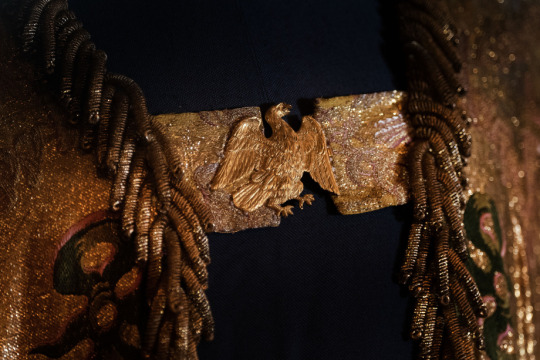
The Imperial Mantle was made by the tailor John Meyer in 1821 and the Royal Goldsmiths to George IV, Rundell, Bridge and Rundell supplied the gold eagle clasp.
The Girdle, also known as the Coronation Sword Belt, is made of cloth of gold, and embroidered in gold thread with arabesques and scrolls. It is lined with dark red silk, with a gold buckle stamped with national emblems (roses, thistles and shamrocks) and a gold clip for attaching the Jewelled Sword of Offering in place.

During the Coronation Service, the Sword Belt is placed around the Supertunica. The Jewelled Sword of Offering is then 'girded' or fastened at the Sovereign's waist using the Sword Belt. The Archbishop presents the Sword to the Monarch while saying that it should be used for the protection of good and the punishment of evil. The Sword is then removed and placed on the altar in Westminster Abbey, before the Sovereign is invested with the Imperial Mantle.
Historically the Sword Belt is supplied new by the Worshipful Company of Girdlers for each Coronation. His Majesty has chosen to reuse the Sword Belt made for the Coronation of his grandfather, King George VI, on 12th May 1937.
The Coronation Glove or gauntlet is made for the Sovereign’s right hand. It was presented by the Worshipful Company of Glovers, made by Dents the glovemakers, and embroidered by Edward Stillwell & Company in 1937. This Glove has been conserved by Dents with support from the Worshipful Company of Glovers and re-presented by the Company ahead of the Coronation on 6th May.
The Glove is worn to hold the Sovereign's Sceptre during the Crowning and then removed before processing to the Throne Chair. At the Coronation on 6th May, the Coronation Glove will be presented to His Majesty by Lord Indarjit Singh of Wimbledon.
63 notes
·
View notes
Text
youtube
Queen Camilla will most likely arrive at Westminster Abbey bareheaded like Queen Alexandra, Queen Mary, and Queen Elizabeth but she may choose to wear the Diamond Diadem like Queen Elizabeth II.
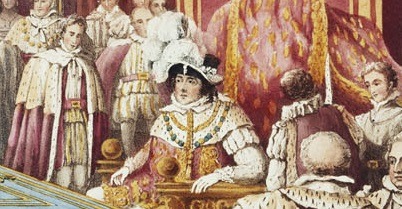
The Diamond Diadem (also called the State Diadem or the George IV Diadem) was created in 1820 by Rundell, Bridge, & Rundell for King George IV to wear during his 1821 coronation. He wore it over a Spanish hat with feathers on the way to Westminster Abbey.
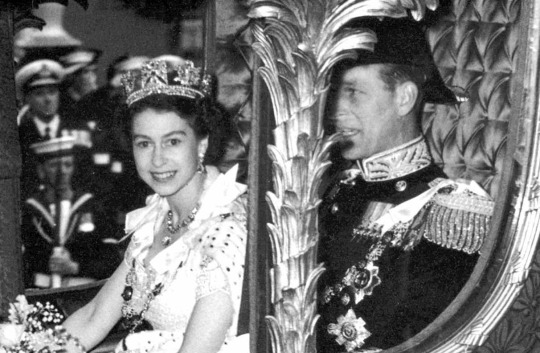
It has since only been worn by women and it occupies a weird space between a crown and a tiara. Previous queens used it a bit more generally just like any other tiara but Queen Elizabeth II only used it for more ceremonial events like the coronation and state opening of Parliament. I don't see the tiara going back to being used as a regular tiara since everyone is so used to the way Queen Elizabeth II wore it. Even if Queen Camilla doesn't use the Diamond Diadem tomorrow, I hope that they release a formal portrait of her wearing it soon.
#Queen Camilla#British Coronation#United Kingdom#British Royal Family#King George IV#Queen Elizabeth II#tiara#diadem#Rundell
51 notes
·
View notes
Text
Reliquary Continued
Revival Chalice 1827/28 Designed by Augustus Welby Northmore Pugin (English, 1812-1852) Made by Rundell, Bridge and Rundell (English, 1797-1843) London Silver gilt incorporating eight spessarite garnet cabochons Gift of the Antiquarian Society, 2013.122 Puggin designed the chalice on the left- a more accurate interpretation of medieval examples-20 years later manufactured by John Hardman and company in base metal and engraved with the word “model” on the underside, it likely served as a sample from which Hardman could solicit further commissions, which would then have been executed in silver or silver gilt. Anti-slavery Medallion 1787 Wedgwood Manufactory (England, founded 1759) Modeled by William Hackwood (England, about 1753-1836) Ethuria, Staffordshire Solid white, jasper and black bessalt, cut steel and ivory frame Amelia Blanxius Memorial Collection, gift of Mrs. Emma B. Hodge and Mrs. Jene E. Bell, 1912.326 Josiah Wedgwood was one of number of prominent English men and woman dedicated to the abolition of the slave trade. Wedgewood freely gave this medallion, inscribed AM I NOT A MAN AND BROTHER?, to like-minded supporters; in 1788 he sent a number of them to Benjamin Franklin in Philadelphia. Bacchus and Two Fawns About 1775 Wedgewood Manufactory (England, founded 1759) Etruria, Staffordshire Stoneware (jasperware) The Frank W. Gunsaulus Collection of Old Wedgewood, 1912.166 Portland Vase 1790/96 Wedgewood Manufactory (England, founded 1759) Etruria, Staffordshire Stonewire (jasperware) Gift of Rosalyn M. Rose, 1979.738 Mercury Joining the Hands of Britain and France 1787/90 Wedgwood Manufactory (England, founded 1759) Etrusia, Staffordshire
0 notes
Photo

Chalice, 1827. Designed by Augustus Welby Northmore Pugin (English, 1812-1852). Made by Rundell, Bridge and Rundell (London, 1797-1843)
147 notes
·
View notes
Photo
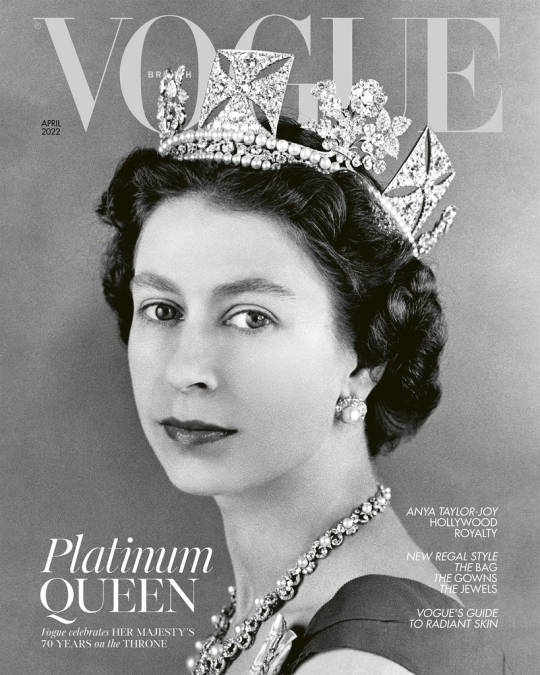
Vogue UK MAGAZINE QUEEN ELIZABETH II PLATINUM JUBILEE SPECIAL - APRIL 2022: Queen Elizabeth II wears her Diamond Diadem in this 1957 portrait, which was taken by Antony Armstrong-Jones.
I say crown, but I should say diadem, since the headgear in question is formally known as the Diamond Diadem. And it may surprise you to know that this ultra-feminine headpiece – which has graced the Queen’s head on stamps and coins throughout her long reign and has been favoured by women on the throne for 200 years – was, in fact, originally made for a man.
George IV (1762-1830) commissioned the piece from then royal jeweller Rundell, Bridge and Rundell for his 1821 coronation. Of course, the Prince Regent, as he had been known since 1811 when he took over the monarchy from his sick father, George III, was famous for his lifelong passion for jewellery and profligate spending on diamonds and other luxuries. His coronation was, unsurprisingly, a lavish affair, and naturally he had to have a suitably splendid crown to accompany him on his procession to Westminster Abbey.
- Rachel Garrahan, Vogue UK’s jewellery and watch director
Platinum Jubilee
#the crown netflix#the crown#queen elizabeth ii#diamond diadem#crown jewels#diadem#british monarchy#brf#british royal family#king george iv#antony armstrong-jones#lord snowdon#portrait#platinum jubilee#coronation#thecrownnet
53 notes
·
View notes
Text

Set of Jewels, Peridot and Gold
Rundell, Bridge & Rundell
1816
London
"On 30 April 1816 the Prince Regent, the future George IV, sent to ‘Miss Coats’ a set of peridots to wear at the marriage of his daughter, Princess Charlotte, and Prince Leopold of Saxe-Coburg. ‘Miss Coats’ was either Charlotte or Lucy Cotes, two of the ladies in Princess Charlotte’s household who had been entrusted by the Prince Regent with keeping a close eye on the princess."
Via the Victoria and Albert Museum
8 notes
·
View notes
Photo

Box and cover with medal depicting George IV (1762-1830)
Circular tortoishell box and cover. Lid mounted with a glazed laureate right profile portrait medal of George IV as Prince of Wales, inscribed, 'Georgius Princeps Walliae Patriam Pro Patre Regens, MDCCCXIII', printed inside the box is, 'Portrait medal of George IV mounted in lid of tortoise-shell snuff-box on the occasion of Lord Amherst's Embassy to China in 1814. The box was to have been given at the Imperial Court but the Embassy proved abortive and no presentations were made'.
12 notes
·
View notes
Text

The birthstone for December is turquoise, which shows brightly among the decoration on this chalice.
The chalice was created by the royal goldsmiths Rundell, Bridge & Rundell, in imitation of works found in the treasuries of European princes of the 16th and 17th centuries. The base of the cup is formed from a George IV coronation medal and the panels which form the bowl are rock crystal. The chalice is on display in the Lantern Lobby at Windsor Castle.
~ The Royal Collection Trust
49 notes
·
View notes
Text
Sun[day] 9 October 1836
9 1/4
11
+
L
L
+
No kiss ready in an h[ou]r and br[eak]f[as]t - Mr. Jubb w[a]s co[me] - my a[un]t m[u]ch the sa[me] - A- [Ann] bet[ter] - Cookson go[in]g on well
n[o]t to get up till ev[enin]g - fine morn[in]g - out 1/4 h[ou]r w[i]th A- [Ann] on the flags the 1st ti[me] she h[a]s been out
s[in]ce being poor[l]y i.e. s[in]ce yest[erday] week - on leav[in]g A- [Ann] ly[in]g d[o]wn on the sofa, w[e]nt to my a[un]t for a min[ute]
or 2 then saunt[ere]d in the walk ab[ou]t an h[ou]r till 12 1/2 then sat w[i]th my a[un]t whi[le] Oddy din[e]d –
and aft[er]w[ar]ds she prepar[e]d a lit[tle] arrow root for A- [Ann] (dur[in]g this ti[me] r[ea]d fr[om] p[age] 64 to 87 alph[abe]t of
Phys[ica]l geog[raph]y) - then sat w[i]th A- [Ann] whi[le] she took h[e]r arrow root, and ga[ve] h[e]r n[ea]r a sm[all] wine gl[ass] full of
Malmsey Madeira w[hi]ch she seem[e]d to enjoy – s[ai]d it w[a]s the best th[in]g she h[a]d tast[e]d for long - at
my desk at 2 3/4 at w[hi]ch h[ou]r fair ag[ai]n - a heavy show[e]r just aft[e]r I ca[me] in at 12 1/2 and r[ai]n mo[re]
or less fr[om] then to now (now 2 3/4) – wr[ote] and s[e]nt this ev[enin]g Let[ter] to ‘Mr. Hutton Tailor etc. etc.
114 Park st[reet] Grosvenor St[reet] Lond[on]’ enclos[in]g ord[e]r on Messrs. Hamm[erlse]ys for £10.10.0 being the am[oun]t
of Hutton’s bill for my pelisse + the 3/6 p[ai]d to Rundell and Bridge for repair[in]g my M[ac]l[ean] watch – wr[ote] als[o] and
s[e]nt let[ter] to ‘Fanny Hardy, Binhove, Winster, Bakewell, Derbyshire p[ost]p[ai]d’ say[in]g I h[a]d h[a]d (Miss List[e]r
etc. etc. wr[ote] in the 3[r]d pers[o]n) a let[te]r fr[om] a lady wh[o]se na[me] I h[a]d been una[ble] to r[ea]d recomm[endin]g FH- [Fanny Hardy] as cook –
and that I beg[ge]d to inf[or]m her the cook’s pl[ac]e at Shibd[e]n Hall w[oul]d n[o]t suit her – fr[om] 5 to din[ner] at 6 1/2 sat w[i]th my
a[un]t - a few min[ute]s w[i]th h[e]r bet[ween] din[ner] and coff[ee] - then sat w[i]th h[e]r fr[om] 8 to 10 1/2 - a gr[ea]t change s[in]ce
morn[in]g – ver[y] weak b[u]t restless – g[o]t up ab[ou]t 6 - and ag[ai]n in ab[ou]t 2 h[ou]rs and ag[ai]n at 10 1/2 – b[u]t I
trust she will now settle for a lit[tle] whi[le]? the h[ou]sem[ai]d w[i]th Oddy - the latt[e]r to lie d[o]wn for
2 or 3 h[ou]rs whi[le] the h[ou]sem[ai]d watches - I shall n[o]t ta[ke] my cl[o]thes off - A- [Ann] sat by me fr[om] ab[ou]t 9 to
10 1/2- I r[ea]d at interv[a]ls the alph[abe]t of physic[a]l geog[raph]y and tonight’s pap[e]r - fine day till 12 1/2 – aft[er]w[ar]ds
ver[y] show[er]y aft[ernoo]n – F[ahrenheit] 48° now at 11 p.m. - Lay d[o]wn w[i]th my clothes on – qui[te] dress[e]d ready to get up
at any mom[en]t –
4 notes
·
View notes
Photo

Candlestick, one of a pair, Rundell, Bridge &, 1824-1825, Minneapolis Institute of Art: Decorative Arts, Textiles and Sculpture
George IV Gothic Revival; six lobes on foot; hexagonal tapered shaft; round rim; bulb above foot has alternating three-dimensional leaves and tiny frogs; three-dimensional collar below candle cup with repeating leaf designs Size: 10 1/4 × 5 1/16 × 5 1/16 in. (26 × 12.86 × 12.86 cm) Medium: Silver gilt
https://collections.artsmia.org/art/119403/
12 notes
·
View notes
Photo




By the book it’s nearly a complete ensemble, though it does give the impression of being rather cobbled together. The plain cotton waistcoat, a touch too tight in the chest and loose in the waist, is much improved by floral embroidery added after it was acquired. The carefully polished buttons on the homely chestnut tailcoat help distract from the roughly hemmed sleeves. A plush velvet ribbon, the material finer than the fabric of any of Adelson’s clothes, aids in tying back his hair. The highlight, of course, an elegantly engraved pocket watch, courtesy of Rundell & Bridge.
The only thing that’s missing? An invitation.
6 notes
·
View notes